ทำความเข้าใจกับ StarkWare: ผู้ให้บริการโซลูชันเลเยอร์ 2 ที่อยู่เบื้องหลัง dYdX และ iMMUTABLE
เขียนโดย: msfew@Foresight Ventures
รู้เบื้องต้นเกี่ยวกับสตาร์คแวร์
StarkWare แก้ปัญหาความสามารถในการปรับขนาดและความเป็นส่วนตัวของบล็อกเชนเป็นหลัก StarkWare ได้พัฒนาโซลูชันที่สมบูรณ์โดยใช้เทคโนโลยี STARK เพื่อสร้างและตรวจสอบหลักฐานความสมบูรณ์ของการคำนวณผ่านโหมด zk-Rollups และ Validium เพื่อสร้าง Volition การพิสูจน์การเข้ารหัสของ StarkWare สามารถบรรลุผลเป็นศูนย์ ความรู้ ความเรียบง่าย ความโปร่งใส และการรักษาความปลอดภัยหลังควอนตัม ผลิตภัณฑ์ที่พัฒนาโดย StarkWare ส่วนใหญ่ประกอบด้วย: StarkNet, StarkEx, Cairo
ความสามารถในการปรับขนาด
ความสามารถในการปรับขนาด
StarkWare ช่วยให้บล็อกเชนปรับขนาดได้อย่างมากโดยอาศัยการพิสูจน์การเข้ารหัสที่สร้างขึ้นโดยผู้ตรวจสอบออฟไลน์ในระบบคลาวด์ จากนั้นจึงตรวจสอบโดยสัญญาอัจฉริยะบนเชน
ความเป็นส่วนตัว
ประสบการณ์การใช้งาน
ประสบการณ์การใช้งาน
จากตัวอย่างของ iMMUTABLE และ dYdX เราสามารถสัมผัสได้ถึงความสามารถในการขยายที่แข็งแกร่งของโซลูชันที่ StarkWare จัดหาให้ ค่า TPS ของ DiversiFi ที่จ่ายสามารถสูงถึง 18k ค่าธรรมเนียมการหล่อ NFT ของ iMMUTABLE เพียง 0.2 เซ็นต์ และค่าธรรมเนียมการทำธุรกรรมของ dYdX จะลดลง ถึง 1/50 การยืนยันครั้งที่สองอัตราค่าธรรมเนียมเกือบ 0 นำประสบการณ์ผู้ใช้ที่ยอดเยี่ยม
เหตุการณ์สำคัญ
2018: เผยแพร่เอกสารไวท์เปเปอร์ของ STARK, Ethereum Foundation Grant
2019: เดโมตัวแรกเปิดตัว (เพิ่มประสิทธิภาพของ Ethereum ถึง 200 เท่า) StarkEx Alpha เปิดตัวเครือข่ายทดสอบ และเดโมชุดที่สองเปิดตัว (เพิ่มประสิทธิภาพของ Ethereum ถึง 700 เท่า)
2020: DeversiFi (StarkEx 1.0) เปิดตัวเครือข่ายหลัก, VeeDo (VDF ที่ใช้ Stark) เปิดตัวเครือข่ายหลัก, StarkEx Rollup เปิดตัวเครือข่ายหลัก, ethSTARK เปิดตัว, ไคโร (ภาษา Turing ที่สมบูรณ์สำหรับ STARK) และการเปิดตัว PlayGround, Ziggy STARK ( ต่อมา Quantum Safe Security Signature) เปิดตัวแล้ว StarkEx 2.0 เปิดตัว Mainnet
2021: StarkNet ประกาศเปิดตัวโครงการ dYdX และ Immutable X (ทั้งลูกค้า StarkWare) mainnet
อิมมิวเทเบิลและสตาร์คแวร์
iMMUTABLE เป็นแพลตฟอร์มการซื้อขาย NFT เลเยอร์ 2 แรก Tik Tok ร่วมมือกับ iMMUTABLE ในเดือนกันยายนและเปิดตัวชุดของ NFT
เนื่องจากทรูพุตในเครื่องของ Ethereum ถูกจำกัดที่ 4 ธุรกรรม/วินาที DApp ใดๆ ที่ต้องการปรับขนาดจึงถูกจำกัด สำหรับ NFT คอขวดของทรูพุตนั้นยิ่งใหญ่กว่าโทเค็นทั่วไป ด้วย NFT โทเค็นหนึ่งพันโทเค็นใช้ทรัพยากรบล็อกเชนจริงๆ เป็นพันเท่าของ Token เดียว iMMUTABLE หวังว่าจะใช้โซลูชันเนทีฟของ Ethereum เพื่อเพลิดเพลินกับความปลอดภัย เครื่องมือพัฒนา และเอฟเฟกต์เครือข่ายของ Ethereum ดังนั้นจึงใช้โซลูชันที่ StarkWare จัดหาให้
หนึ่งในคุณสมบัติพิเศษของโซลูชันที่นำเสนอโดย StarkWare คือความสามารถในการปรับใช้ในโหมดความพร้อมใช้งานของข้อมูลหลายโหมด: zk-Rollups หรือ Validium ทั้งคู่ขึ้นอยู่กับการพิสูจน์ความถูกต้อง แต่ใน zk-Rollups ข้อมูลทั้งหมดอยู่บนเครือข่าย อย่างไรก็ตาม ใน Validium ข้อมูลจะถูกเก็บไว้แบบ off-chain และส่งเฉพาะสถานะล่าสุดเท่านั้นรวมถึงการส่งหลักฐานความถูกต้องของสถานะแบบ on-chain iMMUTABLE เริ่มต้นด้วยโหมด Validium ซึ่งให้ค่าก๊าซที่ต่ำกว่า เนื่องจากนโยบายและ ข้อบังคับ ระเบียบ คณะกรรมการความพร้อมใช้งานของข้อมูล (DAC) ช่วยให้มั่นใจว่าผู้ใช้สามารถเข้าถึงข้อมูลของตนได้เสมอ ดังนั้น iMMUTABLE จึงเปลี่ยนไปใช้รูปแบบความพร้อมใช้งานของข้อมูลแบบใหม่ของ Volition ซึ่งจะช่วยให้ผู้ใช้สามารถเลือกได้ว่าข้อมูลของตนจะถูกเก็บไว้ที่ใด—บนเครือข่าย (zk-Rollups) หรือแบบออฟไลน์ (Validium) ในขณะเดียวกัน วิธีการนี้ยังช่วยขยายประสิทธิภาพสูงสุดอีกด้วย
ในบล็อกโพสต์เกี่ยวกับความร่วมมือระหว่าง Tik Tok และ iMMUTABLE Tik Tok กล่าวถึงอย่างเฉพาะเจาะจงว่า StarkWare เป็นโซลูชันการขยายตัว L2 ที่เป็นกลางทางคาร์บอนตัวแรก จากมุมมองของบริษัทอินเทอร์เน็ตแบบดั้งเดิม การปกป้องสิ่งแวดล้อมจึงมีความสำคัญมาก ดังนั้น ประสิทธิภาพและทรัพยากรที่สูงของ L2 คุณสมบัติการประหยัดยังสามารถดึงดูดความสนใจของบริษัทอินเทอร์เน็ตแบบดั้งเดิม ปูทางให้พวกเขาเข้าสู่ฟิลด์ cryptocurrency อย่างเปิดเผย
โซลูชันที่ StarkWare มอบให้กับ iMMUTABLE ในที่สุดทำให้ Tik Tok ซึ่งเป็นบริษัทที่ได้รับความนิยมสูงสุดในปัจจุบันพบ iMMUTABLE สำหรับความร่วมมือ โหมดการปรับใช้ 2 โหมดที่ StarkWare จัดหาให้ช่วยให้ลูกค้ามีความยืดหยุ่นในวิธีการจัดเก็บข้อมูลซึ่งไม่เพียงปฏิบัติตามกฎระเบียบเท่านั้น ประสิทธิภาพ สามารถขยายได้ ที่สำคัญ การขยายประสิทธิภาพยังช่วยแก้ปัญหาการใช้พลังงานที่ขัดแย้งของ Ethereum นี่จะเป็นชัยชนะของ Layer 2 และ StarkWare ในอนาคต เราจะได้เห็นองค์กรแบบดั้งเดิมเลือกใช้ Ethereum และ StarkWare มากขึ้นอย่างแน่นอน เพื่อเข้าสู่ช่องบล็อกเชน
เหตุใดแอปพลิเคชัน StarkWare จึงมีประสิทธิภาพสูงเช่นนี้
Prover ของ StarkWare มีการเพิ่มประสิทธิภาพทางคณิตศาสตร์ที่หลากหลายและอัลกอริธึมการปรับให้เหมาะสมบางอย่างที่ StarkWare นำเสนอเป็นครั้งแรก และภาษาไคโรที่ใช้ในการพัฒนามีการเพิ่มประสิทธิภาพพิเศษที่เกี่ยวข้องกับคณิตศาสตร์ นอกจากนี้ ก่อนที่ข้อมูลเชิงโต้ตอบจะถูกส่งไปยัง Prover เอ็นจิ้น StarkEx จะถูกใช้เพื่อประสานงานข้อมูลที่จะพิสูจน์และประมวลผลเป็นชุด กระบวนการทำงานทั้งหมดได้รับการปรับให้เหมาะสมสำหรับการครอบคลุมทั้งหมด รายละเอียดจะกล่าวถึงในรายละเอียดในภายหลัง
แอปพลิเคชัน StarkWare มีการกระจายอำนาจอย่างไร
ฉันทามติใน StarkNet ของ StarkWare คือ zk-STARK zk-Rollups ไม่จำเป็นต้องกระจายอำนาจและไม่มีข้อจำกัดในการเข้าถึง อย่างไรก็ตาม zk-STARK ที่ StarkWare ใช้ไม่มีข้อจำกัดในการเข้าถึง เช่นเดียวกับเชนสาธารณะ เช่น Ethereum ในกระบวนการกลางของ แอปพลิเคชันที่สร้างโดย StarkWare จะมีเซิร์ฟเวอร์ส่วนกลางบางส่วนเพื่อให้บริการบางอย่าง แต่สิ่งนี้จำเป็นและไม่สามารถลบออกได้ในการพัฒนาแอปพลิเคชันที่สมบูรณ์ เช่นเดียวกับ uniswap จะต้องมีชื่อโดเมนส่วนกลางและส่วนหน้าเหมือนกัน ดังนั้น dYdX , StarkNet และอื่น ๆ ที่สร้างโดย StarkWare ยังคงกระจายอำนาจ
zkSync กับ StarkWare
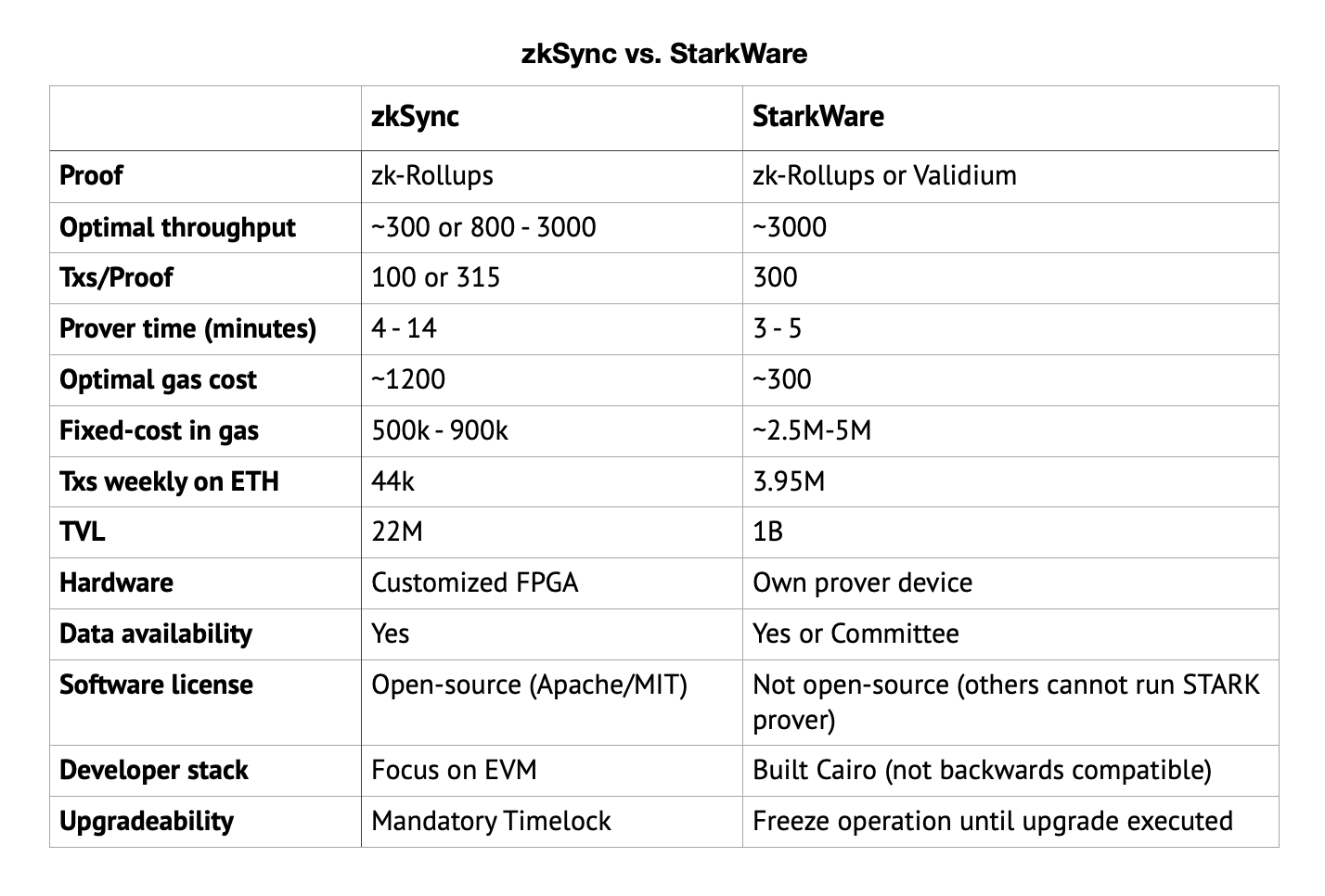 ปัจจุบัน StarkWare นำหน้า zkSync ในแง่ของประสิทธิภาพและสถานะการทำงานปัจจุบัน ความแตกต่างที่ใหญ่ที่สุดระหว่าง zkSync และ StarkWare คือแนวคิดในการดำเนินงาน โครงการของ zkSync เป็นโอเพ่นซอร์สทั้งหมด และไม่สำคัญว่าทีมงานจะบอกว่าพวกเขาเป็น แทนที่ตราบเท่าที่พวกเขาสามารถส่งเสริมการพัฒนาของชุมชนและ Ethereum ได้ StarkWare เป็นโหมดการทำงานแบบรวมศูนย์ของ toB และตัวพิสูจน์ STARK สามารถใช้ได้โดย StarkWare ในปัจจุบัน และภาษาไคโรไม่ได้เป็นประโยชน์ต่อ Ethereum มากนัก ระบบนิเวศน์ (เป็นมิตรกับนักพัฒนา แนวทางควรรองรับ EVM เช่น zkSync หรือ Optimistic)
ปัจจุบัน StarkWare นำหน้า zkSync ในแง่ของประสิทธิภาพและสถานะการทำงานปัจจุบัน ความแตกต่างที่ใหญ่ที่สุดระหว่าง zkSync และ StarkWare คือแนวคิดในการดำเนินงาน โครงการของ zkSync เป็นโอเพ่นซอร์สทั้งหมด และไม่สำคัญว่าทีมงานจะบอกว่าพวกเขาเป็น แทนที่ตราบเท่าที่พวกเขาสามารถส่งเสริมการพัฒนาของชุมชนและ Ethereum ได้ StarkWare เป็นโหมดการทำงานแบบรวมศูนย์ของ toB และตัวพิสูจน์ STARK สามารถใช้ได้โดย StarkWare ในปัจจุบัน และภาษาไคโรไม่ได้เป็นประโยชน์ต่อ Ethereum มากนัก ระบบนิเวศน์ (เป็นมิตรกับนักพัฒนา แนวทางควรรองรับ EVM เช่น zkSync หรือ Optimistic)
zk-Rollups และ STARK ปรู๊ฟ
เทคโนโลยีที่ใช้โดย StarkWare ได้แก่ zk-Rollups และ zk-STARK ทั้งสองนี้ไม่เหมือนกัน STARK คือ zk-STARK ซึ่งเป็นหลักฐานที่ไม่มีความรู้
StarkWare มักจะเรียกโซลูชันของตนว่า Validity Rollups เนื่องจากไม่จำเป็นต้องใช้ zk-Rollups ในโซลูชัน Validity Rollups รวมถึง Validium และ zk-Rollups ความแตกต่างระหว่างสองสิ่งนี้คือข้อมูลผู้ใช้อยู่บนเครือข่ายหรือไม่
https://immutablex.medium.com/eli5-nft-scaling-solutions-b1de4ad82461
STARK ปรับปรุงความสามารถในการขยายขนาดโดยอนุญาตให้นักพัฒนาย้ายการประมวลผลและการจัดเก็บแบบ off-chain บริการแบบ off-chain จะสามารถสร้างการพิสูจน์ของ STARK ที่ยืนยันถึงความสมบูรณ์ของการประมวลผลแบบ off-chain จากนั้นการพิสูจน์เหล่านี้จะถูกส่งกลับแบบ on-chain เพื่อตรวจสอบโดยผู้มีส่วนได้ส่วนเสีย การคำนวณ ใช้ STARK เพื่อย้ายงานด้านการคำนวณส่วนใหญ่ออกจากเครือข่าย ทำให้โครงสร้างพื้นฐาน blockchain ที่มีอยู่ปรับขนาดได้แบบทวีคูณในขณะที่รักษาความสมบูรณ์ของการคำนวณ
กระบวนการทั่วไปของการโยงข้อมูล Ethereum: 1,000 ธุรกรรมถูกส่งไปยังแต่ละโหนดของ Ethereum → แต่ละโหนดอ่าน 1,000 ธุรกรรม → โหนดอัปเดต 1,000 ธุรกรรม
zk-STARK data on-chain process: 1,000 รายการถูกส่งไปยัง zk-STARK → zk-STARK ทำหน้าที่เป็นผู้พิสูจน์ สร้างใบรับรอง 1 ใบ (* generation stage) → โหนดอ่านใบรับรองในฐานะผู้ตรวจสอบ อัปเดต
*ขั้นตอนการสร้าง: โดยปกติแล้วการพิสูจน์ zk-STARK ต้องการกระบวนการต่อไปนี้เพื่อสร้างการพิสูจน์ กระบวนการพิสูจน์ของผู้ตรวจสอบแบ่งออกเป็นสองขั้นตอน: ขั้นตอนแรกคือการสร้างการแสดงรหัสกลางเชิงพีชคณิตหลังจากคำนวณคำชี้แจงความสมบูรณ์ และขั้นตอนที่สอง คือการผ่านการทดสอบ Generate FRI (วิธีการเพิ่มประสิทธิภาพสำหรับการพิสูจน์ในเอกสารที่เขียนโดยผู้ร่วมก่อตั้ง StarkWare ในปี 2560) จากนั้นจึงแสดงอาร์กิวเมนต์ความรู้แบบเปิดและโปร่งใสที่ขยายได้ (นั่นคือ STARK) หลังจากอัลกอริทึมการเข้ารหัส กล่าวโดยย่อ ผ่านสภาพแวดล้อมที่ปลอดภัยและเชื่อถือได้และอัลกอริทึมที่ปรับให้เหมาะสมเพื่อสร้างหลักฐานที่น่าเชื่อถือและมีประสิทธิภาพสูง
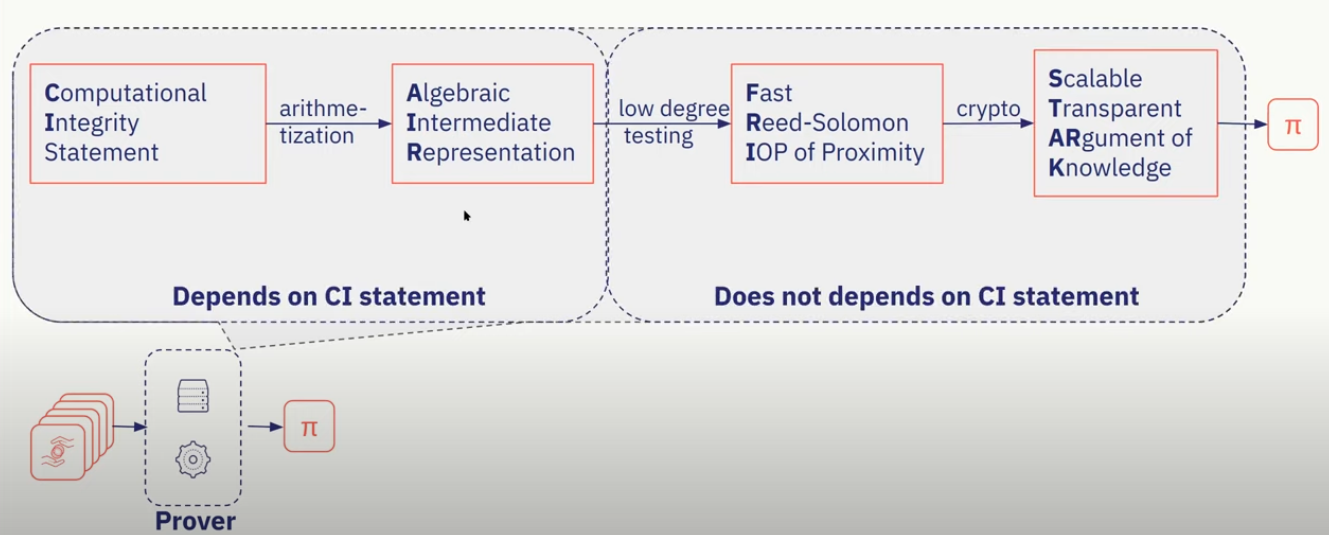
zk-Rollups เมื่อเทียบกับโครงร่าง L2 อื่น ๆ
กล่าวอย่างเคร่งครัด คำว่า zk-Rollups ที่ใช้ในเอกสาร StarkWare จำนวนมากไม่จำเป็นต้องใช้การพิสูจน์ความรู้เป็นศูนย์และคำอธิบายที่ถูกต้องคือหลักฐานความถูกต้อง (รวมถึง zk-Rollups และ Validium เนื่องจาก StarkWare มีสองโหมด) เพื่อหลีกเลี่ยงการเปลี่ยนแปลงคำศัพท์ส่งผลกระทบต่อ ทำความเข้าใจ บทความนี้อ้างถึงการแสดงออกที่เกี่ยวข้องเป็น zk-Rollups ตามเอกสาร StarkWare
ไซด์เชน (โพลิกอนหรือ xDai)
ข้อดี: แม้ว่าผู้ใช้จะทำธุรกรรมจำนวนมาก แต่มีเพียง 2 สิ่งเท่านั้นที่เกิดขึ้นบน main chain นั่นคือ การฝาก และ การถอน เนื่องจากต้นทุนการทำธุรกรรมบน side chain นั้นต่ำกว่า Ethereum เอง จึงสามารถรับความสามารถในการขยายขนาดได้
ช่องทางของรัฐ
ช่องทางของรัฐ
ข้อดี: ตัวอย่างของช่องสถานะคือ Lightning Network ช่องสัญญาณของรัฐมีประโยชน์เมื่อผู้เข้าร่วมจะแลกเปลี่ยนการอัปเดตสถานะจำนวนมากในช่วงเวลานาน มีความเป็นส่วนตัวสูง เนื่องจากสถานะระหว่างกันจะเกิดขึ้นภายในช่องสัญญาณเท่านั้น ตอนจบ พอจบก็จบทันที
ข้อเสีย: ช่องทางของรัฐขึ้นอยู่กับความถูกต้องและเหมาะสำหรับแอปพลิเคชันที่มีผู้เข้าร่วมบางกลุ่ม
Plasma
ข้อดี: Plasma เหมาะมากสำหรับการจัดการกับ NFT เนื่องจาก NFT แต่ละตัวมี ID ที่ไม่ซ้ำกัน หนึ่งในปัญหาของ sidechains คือกลไกที่สอดคล้องกันสามารถหยุดการผลิตบล็อกหรือแม้แต่ล็อคเงินทุนของผู้ใช้ ผู้ใช้ Plasma สามารถเรียก Block root ได้ ดังนั้นหาก กลไกฉันทามติหยุดสร้างบล็อก ผู้ใช้ยังคงสามารถขอเงินจาก Ethereum ได้
ข้อเสีย: หากผู้ใช้หลายคนออกจาก Plasma chain พร้อมกัน พวกเขาอาจล้นรูทเชนและทำให้เครือข่ายแออัดได้ สิ่งต่างๆ เช่น การฉ้อฉลหรือการโจมตีทางไซเบอร์อาจทำให้เกิดการอพยพครั้งใหญ่ได้ ข้อเสียอีกประการหนึ่งคือการขาดความซับซ้อน ผู้ใช้ไม่สามารถ ดำเนินการที่ซับซ้อนประเภทเดียวกันกับที่ทำได้บน sidechains โดยจำลองสภาพแวดล้อม Ethereum เต็มรูปแบบ
zk-Rollups
ข้อดี: ต้นทุนต่อการถ่ายโอนต่ำ เร็วกว่า Plasma และ Optimistic Rollups ข้อมูลน้อยนำไปสู่ปริมาณงานและความสามารถในการปรับขนาดที่สูงขึ้น จุดด้อย: การตั้งค่าเริ่มต้นไม่มีการกระจายอำนาจ (ไม่มีการตั้งค่าเริ่มต้นใน STARK) คอมพิวเตอร์ควอนตัมอาจก่อให้เกิดภัยคุกคามจากการแฮ็กในอนาคต (STARK สามารถต้านทานควอนตัมได้ คอมพิวเตอร์)
หลังจากเปรียบเทียบโซลูชัน L2 ต่างๆ แล้ว เราพบว่า zk-Rollups อาจเป็นโซลูชันที่สมบูรณ์แบบซึ่งใกล้เคียงกับการอัปเกรดและการขยายบล็อกเชนมากที่สุด ขณะเดียวกัน ข้อบกพร่องเล็กน้อยของ zk-Rollup จะพบได้ใน zk-STARK ที่นำมาใช้โดยโปรแกรมแก้ไข StarkWare
การเปรียบเทียบประสิทธิภาพระหว่าง STARK กับ ZK อื่นๆ
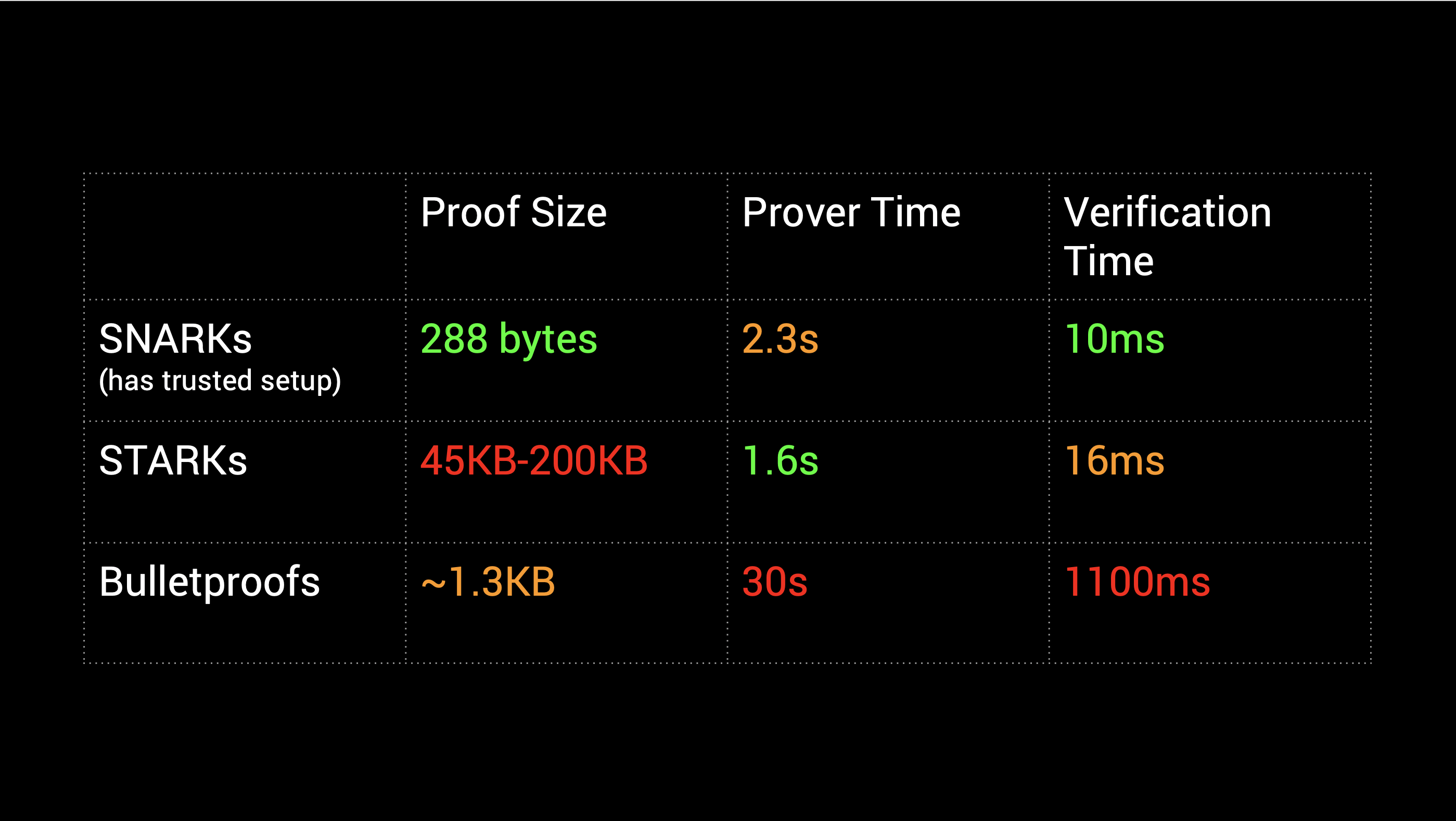
การพิสูจน์ ZK มีสามประเภทหลัก: SNARK, STARK และ Bulletproof Bulletproofs และ STARK ไม่ต้องการการตั้งค่าที่เชื่อถือได้ และ STARK ใช้การสุ่มที่ตรวจสอบได้แบบสาธารณะเพื่อสร้างระบบคอมพิวเตอร์ที่ไม่น่าเชื่อถือและตรวจสอบได้ เมื่อเทียบกับอีก 2 แบบ STARK ขนาดการพิสูจน์ มีขนาดใหญ่มากแต่มีข้อได้เปรียบอย่างมากในด้านขนาดการคำนวณและความเร็วในการพิสูจน์ ขณะเดียวกัน STARK ก็มีความปลอดภัยสูงกว่าและสามารถต้านทานการโจมตีแบบควอนตัมได้
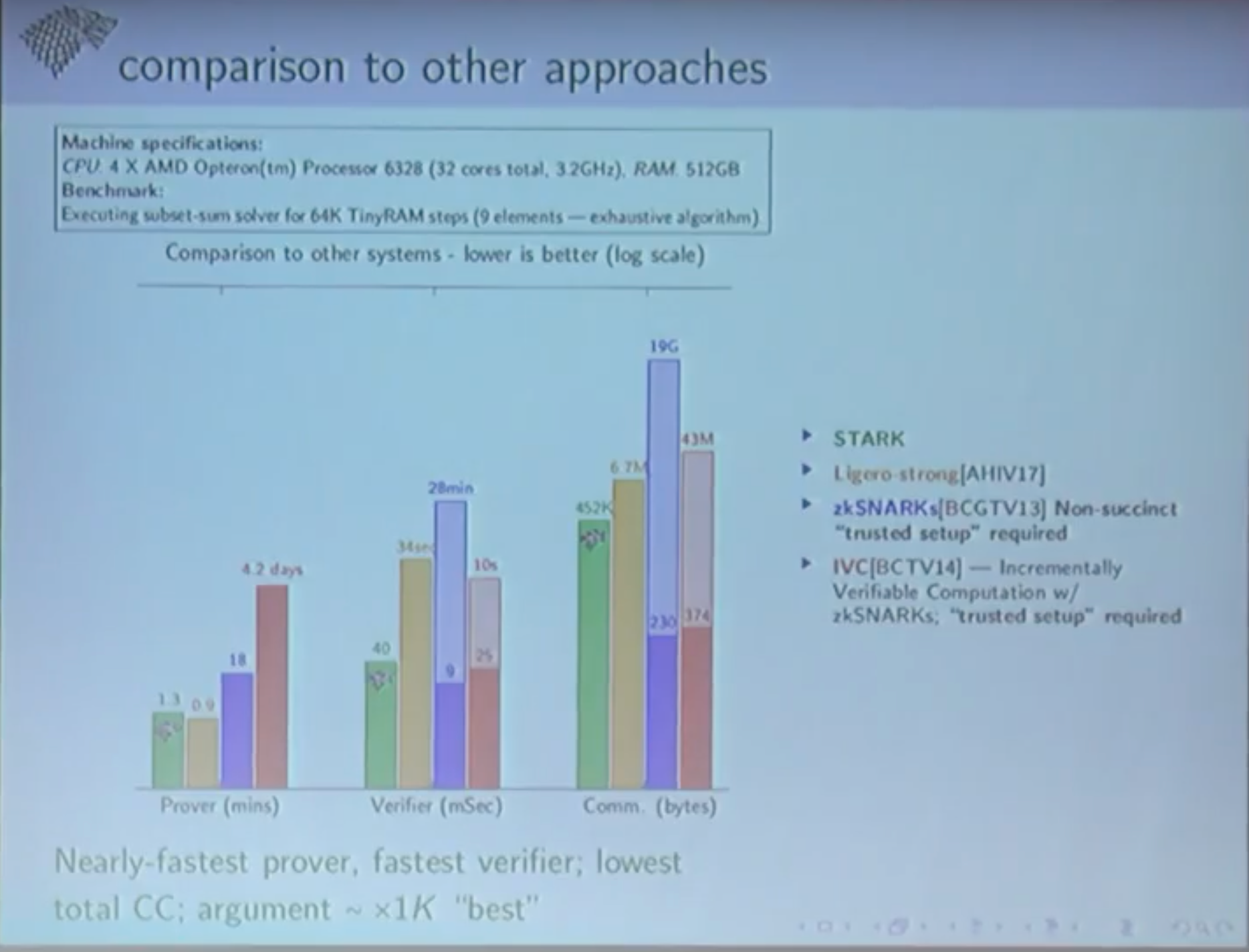
ชื่อระดับแรก
StarkNet
StarkNet Alpha จะเปิดตัวบน Ethereum mainnet ในเดือนพฤศจิกายน
การแนะนำhttps://voyager.online
การแนะนำ
StarkNet เป็น L2 zk-Rollups แบบกระจายอำนาจ ไม่มีการอนุญาต และป้องกันการเซ็นเซอร์ซึ่งสนับสนุนการประมวลผลเพื่อวัตถุประสงค์ทั่วไปบน Ethereum โดยอ้างอิงจากภาษาไคโรของ Turing ที่สมบูรณ์ นักพัฒนาสามารถสร้างแอปพลิเคชันเพื่อใช้ตรรกะทางธุรกิจของแอพและปรับใช้บน StarkNet ผู้ใช้สามารถ ส่งธุรกรรมไปยัง StarkNet เพื่อดำเนินการในลักษณะเดียวกับธุรกรรม Ethereum ปกติ โหนด StarkNet และผู้เข้าร่วมจะได้รับสิ่งจูงใจทางเศรษฐกิจเพื่อให้แน่ใจว่าเครือข่ายทำงานได้อย่างมีประสิทธิภาพและเป็นธรรม
ธุรกรรมของ StarkNet ทั้งหมดจะถูกแบทช์เป็นประจำและธุรกรรมจะได้รับการพิสูจน์ในการพิสูจน์ของ STARK และสุดท้ายจะได้รับการยืนยันบน Ethereum เนื่องจากความพยายามทางคอมพิวเตอร์ที่จำเป็นในการตรวจสอบการพิสูจน์ของ STARK นั้นน้อยกว่าการพิสูจน์ของ Ethereum แบบทวีคูณ ดังนั้น StarkNet จึงสามารถขยาย Ethereum ได้หลายรายการ ลำดับความสำคัญ เนื่องจากการเปลี่ยนสถานะของ StarkNet ทั้งหมดจะได้รับการยืนยันโดย STARK ดังนั้น Ethereum จะยอมรับเฉพาะการเปลี่ยนสถานะสุดท้ายที่ถูกต้องเท่านั้น
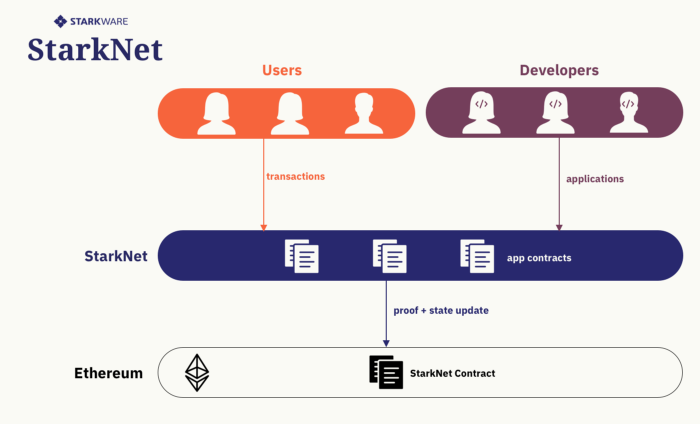
คุณสมบัติหลัก: ความสามารถในการปรับขนาดประสิทธิภาพ ความสะดวกในการพัฒนา และความสามารถในการจัดองค์ประกอบสำหรับระบบนิเวศ Ethereum
ระบบนิเวศเครือข่าย
ภาษาโปรแกรมไคโร: ไคโรเป็นภาษาโปรแกรมระดับสูงและเฟรมเวิร์กที่สมบูรณ์ของทัวริงซึ่งสามารถใช้สร้างการพิสูจน์ STARK ได้ นักพัฒนาสามารถใช้ไคโรเพื่อกำหนดตรรกะทางธุรกิจ ส่งธุรกรรมไปยัง Shared Prover Service เพื่อตรวจสอบลอจิกแบบออฟไลน์และ การตรวจสอบห่วงโซ่ไคโรพร้อมสำหรับการพัฒนาโครงการอย่างเป็นทางการบน mainnet และพร้อมใช้งานสำหรับนักพัฒนา
บริการตรวจสอบแบบออฟไลน์ บริการ Shared Prover: ก่อนที่ธุรกรรมจะถูกอัปโหลดไปยังเชน ธุรกรรมจะถูกส่งไปยัง Sharp เพื่อตรวจสอบ ตัดสินความสมบูรณ์ของการดำเนินการโปรแกรมแอปพลิเคชัน และคำนวณค่าธรรมเนียมก๊าซสำหรับการตรวจสอบหลักฐานการแบ่งปัน
ผู้พิสูจน์โอเพ่นซอร์ส ethSTARK: ethSTARK มอบความรู้เป็นศูนย์และลายเซ็นความปลอดภัยหลังควอนตัม ethSTARK ประมวลผลธุรกรรม 300,000 รายการในการพิสูจน์บนเครือข่ายหลัก และ TPS สูงถึง 3,000 รายการ ประสิทธิภาพของก๊าซสะสมยังทำลายสถิติโลกและสูงถึง 315 ก๊าซ/tx ซึ่งสูงกว่าธุรกรรม Ethereum บน L1 ซึ่งถูกกว่า เทคโนโลยีนี้เป็นรากฐานที่สำคัญของเลเยอร์การพิสูจน์แนวคิดแบบกระจายอำนาจของ StarkNet
ใช้กรณี
ใช้กรณี
DeversiFi: การทำธุรกรรม TPS 9k, การชำระเงิน TPS 18k
เปลี่ยนแปลงไม่ได้: NFT minting gas 0.2 cents, ธุรกรรม L2 รายวัน > ธุรกรรม L1 รายสัปดาห์
การแนะนำ
StarkEx
การแนะนำ
StarkEx เปรียบเสมือนเครื่องยนต์ระดับล่างที่ประกอบส่วนประกอบเพื่อรองรับการใช้งานโดยใช้ STARK
StarkEx เป็นเอ็นจิ้นความสามารถในการปรับขนาด L2 ที่พร้อมสำหรับการผลิตซึ่งติดตั้งบน Ethereum mainnet ตั้งแต่เดือนมิถุนายน 2020 StarkEx ใช้เทคโนโลยี STARK เพื่อมอบธุรกรรมที่โฮสต์ด้วยตนเองที่ปรับขนาดได้สำหรับแอปพลิเคชันเช่น DeFi และเกม StarkEx รองรับกรณีการใช้งานที่หลากหลาย: การซื้อขายเฉพาะจุด การซื้อขายถาวรและการสร้างและการซื้อขาย NFT ธุรกรรม StarkEx กว่า 50 ล้านรายการได้รับการชำระบนเครือข่ายทดสอบ Ethereum สาธารณะและส่วนตัวก่อนที่จะมีการติดตั้ง mainnet
คุณสมบัติ
คุณสมบัติ
ความสามารถในการปรับขนาดและความสมบูรณ์ของการคำนวณสามารถพึ่งพา StarkEx และโครงสร้างพื้นฐานของ STARK พื้นฐานในการปรับขนาด ในขณะที่ StarkEx รับประกันความสมบูรณ์ของการคำนวณ ด้วยเทคโนโลยี SHARP (Shared Prover) ต้นทุนก๊าซจะถูกตัดจำหน่ายสำหรับแอปพลิเคชันที่ใช้ StarkEx ทั้งหมด
โหมดการปรับใช้ที่หลากหลาย StarkEx สามารถปรับใช้โหมด zk-Rollups (การเผยแพร่ข้อมูลบนเชน) หรือโหมด Validium (การตรวจสอบความพร้อมใช้งานของข้อมูลผ่านเชนด้านข้าง) นอกจากนี้ยังมีโหมดที่กำลังจะมาถึง: Volition ซึ่งอนุญาตให้ผู้ใช้เลือกโหมดความพร้อมใช้งานของข้อมูลด้วยตนเอง
การรวม Wallet StarkWare ให้การสนับสนุนแบบเนทีฟผ่าน Ledger, Authereum และ WalletConnect StarkWare ยังนำเสนอการรวม MetaMask ผ่านการสร้างคีย์ที่เข้ากันได้กับ Web3 (ทำงานร่วมกับกระเป๋าเงินอื่น ๆ ที่มีอยู่มากมาย)
สถาปัตยกรรมและตรรกะทางธุรกิจ

รูปภาพด้านบนเป็นแผนภาพสถาปัตยกรรมแอปพลิเคชันทั่วไปที่ใช้ StarkNet และ StarkEx สมมติว่าแอปพลิเคชันนี้เป็น DEX ที่เรียกว่า Starkswap
แอปพลิเคชันในช่องสีเหลืองด้านซ้ายสุด - ใช้งานแอปพลิเคชันทั้งหมด
คอมโพเนนต์นอกเชนนี้รับธุรกรรมของผู้ใช้และกำหนดตรรกะทางธุรกิจและคำสั่งดำเนินการ คอมโพเนนต์ผ่านธุรกรรมไปยังบริการ StarkEx
คอมโพเนนต์นี้เป็นส่วนหน้าส่วนกลางของแอปพลิเคชัน โดยปกติจะเป็นเว็บหรือไคลเอนต์
บริการ StarkEx ในกล่องสีฟ้าอ่อน - ชุดงานและการประสานงาน
คอมโพเนนต์แบบ off-chain ที่รับผิดชอบในการแบทช์ชุดของการดำเนินการและอัปเดตสถานะของระบบตามการดำเนินการ สำหรับแต่ละแบทช์ มันจะแปลงแบทช์ของการดำเนินการ (ดำเนินการโดยภาษาไคโร ขั้นแรกให้แปลงรหัสไบต์ของ Solidity เป็นสมาร์ท สัญญาของภาษาไคโร ทำงานในโลแคลของไคโร) จะถูกส่งไปยัง SHARP เพื่อพิสูจน์ความถูกต้อง เมื่อพิสูจน์แล้ว จะมีการเผยแพร่สถานะใหม่บนเครือข่าย สถานะจะแสดงด้วยต้นไม้ Merkle โครงสร้างและเนื้อหาของแต่ละรายการ ห้องนิรภัยขึ้นอยู่กับ Varies ขึ้นอยู่กับตรรกะทางธุรกิจเฉพาะที่ใช้ ราก Merkle แสดงถึงสถานะที่จะผูกพันกับห่วงโซ่
SHARP - ตัวรับรองความถูกต้องที่ใช้ร่วมกัน (ปรับแต่งโดย StarkWare สำหรับแอปพลิเคชัน)
SHARP เป็นบริการพิสูจน์ที่ใช้ร่วมกันสำหรับภาษาไคโร โดยได้รับคำร้องขอการพิสูจน์จากแอปพลิเคชันต่างๆ และการพิสูจน์เอาต์พุตเพื่อพิสูจน์ความถูกต้องของการดำเนินการรหัสไคโร การพิสูจน์ผลลัพธ์สามารถใช้ร่วมกันระหว่างคำขอการพิสูจน์หลายรายการ
ชื่อเดิมของคอมโพเนนต์นี้คือ Generic Prover Service ดังนั้นคอมโพเนนต์จึงเป็นเซิร์ฟเวอร์แบ็กเอนด์ซึ่งประกอบด้วยบริการเฉพาะบางอย่าง มีการคาดคะเนว่าติดตั้งบนเซิร์ฟเวอร์ส่วนกลางของ StarkWare
สัญญา StarkEx (สัญญาผู้ตรวจสอบ) - การอัปเดตสถานะ การฝากและการถอน
สัญญามีหน้าที่หลักสองประการ หน้าที่แรกคือการอัปเดตสถานะของระบบหลังจากตรวจสอบว่าตรงตามเงื่อนไขความถูกต้อง และหน้าที่ที่สองคือจัดการการฝากและถอนเงินเข้าและออกจาก StarkEx ในลักษณะที่ไม่ต้องดูแล (ใน ผู้ใช้สามารถถอนเงินได้ทุกกรณี)
ส่วนนี้เป็นสัญญาที่ชาญฉลาดบน Ethereum
ตรรกะทางธุรกิจของ Starkswap เป็นดังนี้:
การประมวลผลคำขอ แอปพลิเคชัน StarkWare ในกล่องสีฟ้าอ่อนจะประมวลผลคำขอของลูกค้า แปลงธุรกรรมเหล่านี้ให้เป็นข้อความที่พิสูจน์ได้ และส่งสิ่งเหล่านี้ไปยัง SHARP ในกล่องสีน้ำเงินเข้ม คำขอทั้งหมดจะถูกส่งและประมวลผลผ่าน API แรกของขั้นตอนแรกและแบทช์ คำสั่งในขั้นตอนที่สองจะถูกส่ง (หนึ่งชุดสามารถรวบรวมหลายคำขอ)
SHARP Proof SHARP โครงสร้างกันรอยสีน้ำเงินเข้ม
หลักฐานการลงทะเบียน SHARP จะโอนหลักฐานไปยัง smart contract ของ on-chain validator ในขั้นตอนที่ 3 ในกล่องสีชมพู
ในขั้นตอนที่สี่ของการเปลี่ยนสถานะการลงทะเบียน แอปพลิเคชัน StarkWare ดำเนินการเปลี่ยนสถานะแอปพลิเคชันในสัญญาอัจฉริยะของ Starkswap ในขั้นตอนที่ห้า เพื่อให้แน่ใจว่าการเปลี่ยนแปลงนั้นถูกต้อง (การตรวจสอบความถูกต้องของ SHARP) สัญญาอัจฉริยะของ Starkswap ยืนยันว่าข้อความการเปลี่ยนแปลงนั้นได้รับการ ลงทะเบียนใน Verifier smart contract ลงทะเบียนใน
ฟังก์ชันและอัลกอริทึมการเข้ารหัส
https://docs.starkware.co/starkex-v3/crypto/stark-curve
รายละเอียดฟังก์ชั่น:
สถานะออฟไลน์:
โครงสร้างยอดคงเหลือและลำดับต้นไม้ Merkle tree รับประกันความปลอดภัยและความน่าเชื่อถือของสถานะกองทุนและหลีกเลี่ยงปัญหาการใช้จ่ายซ้ำซ้อน
Flow Description:
บัญชีออนเชน (ยอดคงเหลือของบัญชีถูกจัดเก็บและจัดการนอกเชน เว้นแต่เงินจะถูกย้ายเข้า/ออกจากบัญชีออนเชน จากมุมมองของ L1 เงินของบัญชีเหล่านี้จะถูกเก็บไว้ภายใต้ StarkEx smart สัญญา.)
เจ้าของ"เจ้าของ"ดังนั้น ผู้ใช้และแอปพลิเคชัน L1 สามารถซื้อขายผ่าน StarkEx และจับคู่คำสั่งซื้อที่รอดำเนินการใดๆ ได้ โมเดลการซื้อขายบนเครือข่ายช่วยให้สามารถทำงานร่วมกันระหว่างแอปพลิเคชัน StarkEx และแอปพลิเคชัน L1 ซึ่งสามารถใช้สำหรับการรวม DeFi หรือใช้โดยผู้รวบรวมสภาพคล่อง)
แนวคิดเฉพาะของ StarkEx:
มีแนวคิดมากมายใน StarkEx ที่แตกต่างจาก Ethereum ดังนั้นการพัฒนาจึงต้องมีการเรียนรู้เพิ่มเติม
https://docs.starkware.co/starkex-v3/starkex-deep-dive/starkex-specific-concepts
นอกจากนี้ StarkEx ยังมีการดำเนินการเฉพาะ เช่น การเข้ารหัสข้อมูล การยืมแฟลชเป็นชุด และการรวม DeFi
อัลกอริทึมการเข้ารหัส:
STARK Elliptic Curve, Pedersen Hash Function,KDF โดยใช้อัลกอริทึมการเข้ารหัสและการอ้างอิงข้างต้นhttps://github.com/authereum/starkware-monorepo/tree/starkex-3.0/packages/starkware-provider#walletconnectการแนะนำ
Cairo
การแนะนำ
ไคโรเป็นแพลตฟอร์มระดับการผลิตแห่งแรกที่สร้างการพิสูจน์ STARK เป็น Turing ที่สมบูรณ์และมีประสิทธิภาพมาก ในการปรับใช้ส่วนประกอบแอปพลิเคชันเลเยอร์ 2 ที่มีประสิทธิภาพสูงและก๊าซต่ำบน StarkNet คุณต้องใช้ไคโรเพื่อเขียนแอปพลิเคชัน ภาษาไคโรคือ ไม่ใช่ภาษาสัญญาพิเศษ แต่สามารถใช้เป็นหลักในการเขียนเนื้อหาที่มีลักษณะเหมือนสัญญา
คุณสมบัติ
คุณสมบัติ
ความสมบูรณ์ของการคำนวณ
Computational Integrity แสดงถึงความยุติธรรมของ Computing โดยปราศจากการกำกับดูแล มี 5 วิธีในการทำให้ Computational Integrity: ความรับผิดชอบที่ธนาคารมอบให้ (เช่น SGX ของ Intel), การพิสูจน์การฉ้อโกง (การสรุปผลในแง่ดี, ระหว่างความรับผิดชอบที่ได้รับมอบหมายและความสามารถในการเล่นซ้ำด้วยคอมพิวเตอร์), การพิสูจน์การเข้ารหัส (zk-STARK) ภาษาไคโรได้รับการยืนยันโดยเอกสารและหลักฐานทางคณิตศาสตร์จำนวนมาก และสามารถสร้าง zk- ได้อย่างปลอดภัยและน่าเชื่อถือ การพิสูจน์ของ STARK เพื่อให้มั่นใจถึงความสมบูรณ์ของการคำนวณ
AIR (การแทนรหัสกลางเชิงพีชคณิต)
การออกแบบภาษา
การออกแบบภาษา
การออกแบบภาษา Cario เป็นไปตามหลักการของ Minimal Variable Language และถูกต้อง ในขณะเดียวกันก็ได้รับการแสดงออกของภาษา (อ่านง่าย สำหรับนักพัฒนา) และประสิทธิภาพการสร้างการพิสูจน์ของ STARK การออกแบบของ ภาษา Cario ไม่ซับซ้อนเกินไป มีเพียง 3 รีจิสเตอร์ (PC, allocation pointer, frame pointer) และชุดคำสั่งที่กระชับ นอกจากนี้ ภาษา Cario ยังรองรับฟังก์ชันที่จำเป็นบางอย่าง เช่น ฟังก์ชัน การเรียกซ้ำ การแตกแขนง การตัดสิน เป็นต้น การออกแบบภาษา Cario ให้ความรู้สึกสอดคล้องกับตรรกะของการพิสูจน์ทางคณิตศาสตร์และมีความเรียบร้อยมากขึ้น
ห่วงโซ่เครื่องมือ
นักแปล (https://github.com/NethermindEth/warp) ,เครื่องเสมือน ปลั๊กอินการแก้ไขสภาพแวดล้อมโค้ด (ปลั๊กอินพร้อมรับโค้ดบน VSCodehttps://github.com/ericglau/cairo-ls),ตัวติดตาม ตัวอย่างโค้ด (https://github.com/starkware-libs/cairo-examples).
นิเวศวิทยาของภาษา
ในปัจจุบัน ระบบนิเวศของภาษาไคโรอาจกล่าวได้ว่าครอบคลุมมากแต่ยังเด็กอยู่ มี tool chain ทุกประเภท ตามดาวของ GitHub ของเครื่องมือเหล่านี้สามารถตัดสินได้ว่าไม่ได้รับความสนใจมากนัก แต่ นักพัฒนาของคลังสินค้ากำลังอัปเดตอย่างต่อเนื่องโดยพื้นฐานแล้วมีการส่งใหม่ภายในสองสัปดาห์ ในอนาคตภาษาไคโรจะเปิดกว้างมากขึ้น หลังจากฝึกอบรมนักพัฒนามากขึ้น งานเขียนรหัสไคโรบนเอ็นจิ้น StarkEx น่าจะเป็น ส่งมอบจาก StarkWare ให้กับนักพัฒนา open source การกระจายอำนาจจะสมเหตุสมผลมาก
ที่สำคัญกว่านั้น OpenZeppelin กำลังใช้เทมเพลตพื้นฐาน เช่น ERC-20 และ ERC-721 ในภาษาไคโร (https://github.com/OpenZeppelin/cairo-contractsสรุป
สรุป
ในฐานะผู้ให้บริการโซลูชัน Layer 2 StarkWare ได้ผลิตผลิตภัณฑ์ระเบิด เช่น dYdX และ iMMUTABLE ในบรรดาโซลูชันต่างๆ เทคโนโลยี zk-STARK ของ StarkWare รองรับธุรกรรมจำนวนมากที่สุดบน Layer 2 การเพิ่มประสิทธิภาพทางคณิตศาสตร์จาก Prover การเพิ่มประสิทธิภาพทางคณิตศาสตร์ของภาษาไคโร และการประสานงานที่พิสูจน์ได้ของเอ็นจิ้น StarkEx ทำให้ StarkNet เป็นเครือข่าย zk-STARK แบบกระจายศูนย์ซึ่งให้ประสิทธิภาพที่สูงมากและปรับกระบวนการดำเนินการให้เหมาะสมที่สุด StarkWare ใช้เทคโนโลยีล้ำสมัยและบริการด้านเทคนิคที่สมบูรณ์รองรับปริมาณธุรกรรมจำนวนมากของแอปพลิเคชัน Layer 2 และจะเปิดรับโอเพ่นซอร์สในอนาคตเพื่อให้เกิดการกระจายอำนาจมากขึ้นและช่วยสร้าง Ethereum 2.0
ลิงก์ที่เกี่ยวข้อง:
iMMUTABLE: https://www.immutable.com/blog/design-architecture, https://medium.com/starkware/starkex-now-for-nfts-bfdc9f4655a2
Layer 2: https://academy.moralis.io/blog/comparing-layer-2-ethereum-scaling-solutions, https://www.bcskill.com/index.php/archives/965.html, https://l2beat.com/faq/
ZK: https://ethereum.stackexchange.com/questions/59145/zk-snarks-vs-zk-starks-vs-bulletproofs-updated/63778, https://consensys.net/blog/blockchain-explained/zero-knowledge-proofs-starks-vs-snarks/, https://medium.com/unitychain/reveal-mysterious-zk-starks-42d00679c05b
StarkNet: https://medium.com/starkware/on-the-road-to-starknet-a-permissionless-stark-powered-l2-zk-rollup-83be53640880, https://starkware.co/product/starknet/, https://medium.com/starkware/starknet-alpha-is-coming-to-mainnet-b825829eaf32
StarkEx: https://docs.starkware.co/starkex-v3/architecture/solution-architecture
Cairo: https://medium.com/starkware/hello-cairo-3cb43b13b209, https://www.youtube.com/watch?v=QPNp8w9rx7o, https://arxiv.org/abs/2109.14534
zkSync: https://www.reddit.com/r/ethereum/comments/q8q822/ama_were_matter_labs_the_team_behind_zksync_the/, https://members.delphidigital.io/reports/ethereum-layer-2-rollup-debate-optimism-starkware-arbitrum-and-zksync/, https://twitter.com/KyberNetwork/status/1372593913786109953, https://blog.kyber.network/research-trade-offs-in-rollup-solutions-a1084d2b444
General: https://academy.moralis.io/blog/what-is-starkware-and-starks



